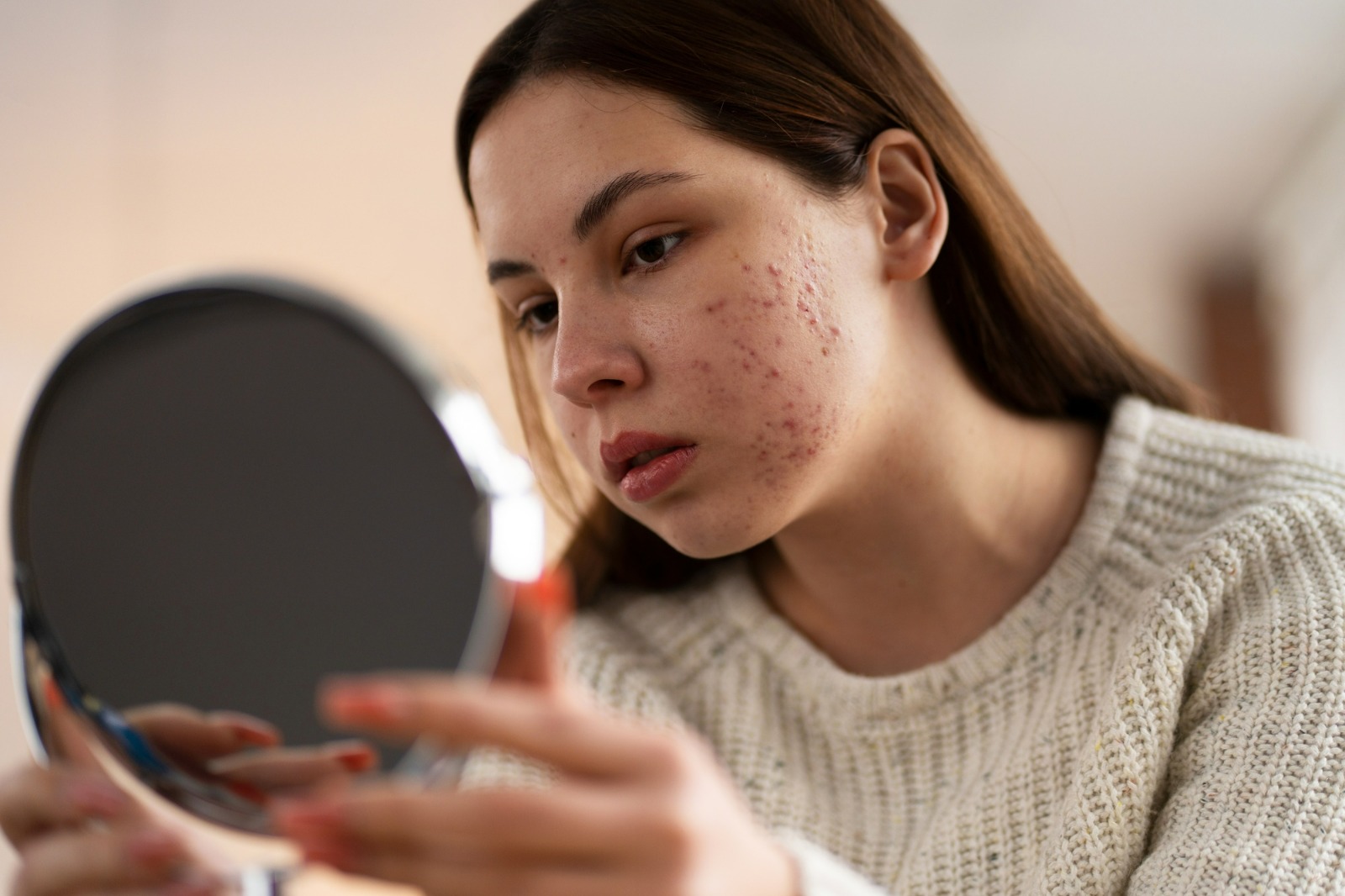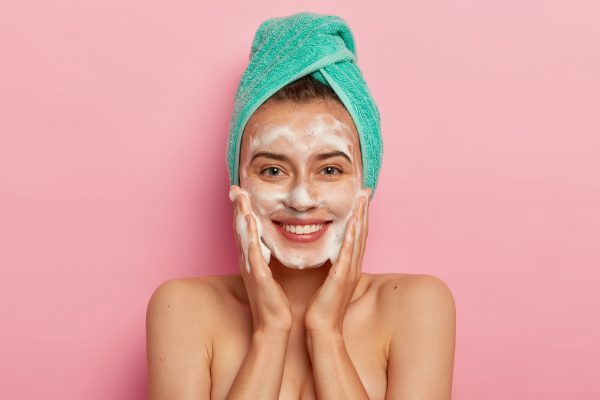
Are you tired of those stubborn bumps that seem to camp out on your forehead? Forehead acne is not just a teenage problem—it can affect anyone, at any age. While it might feel like a small issue, the presence of acne on the forehead can be both frustrating and challenging to address. Our experts will answer all questions regarding the causes, treatment options, and prevention strategies for forehead acne to help you achieve clear, healthy and glowing skin.
What Causes Forehead Acne?
Forehead acne is a common skin condition that can be both bothersome and persistent. Here’s a look at the key factors contributing to this issue:
Excessive Oil Production
The skin on your forehead contains numerous sebaceous glands that produce oil, known as sebum. Overactive glands can lead to excess oil, which can clog pores and create the perfect breeding ground for acne.
Accumulation of Dead Skin Cells
Normally, skin cells renew themselves, shedding the old to make way for the new. However, when this process is disrupted, dead skin cells can accumulate, sticking together with sebum in the pores and forming pimples.
Hair Products and Bangs
Often overlooked, the hair products you use can contribute to forehead acne. Ingredients in shampoos, conditioners, and styling products can trickle down onto the forehead, trapping oil and irritating the skin. Similarly, bangs can exacerbate the issue by adding extra oil and friction to the forehead area.
Hormonal Changes
Hormones play a significant role in skin health. Fluctuations during puberty, pregnancy, or due to conditions like polycystic ovary syndrome (PCOS) can increase oil production, leading to more acne.
Stress
There is a direct connection between stress and skin conditions like acne. During stressful times, your body produces more hormones such as cortisol, which can boost oil production and lead to breakouts.
Diet
Certain dietary factors may influence acne, with foods high in sugar and dairy products sometimes exacerbating the condition.
How to Get Rid of Forehead Acne?
Forehead acne can be a persistent challenge. Here’s a clear and scientifically informed approach to addressing and reducing forehead acne effectively:
1. Consult a Dermatologist
The first step in tackling forehead acne is to consult a dermatologist. They can assess your skin type, identify the specific causes of your acne, and recommend personalised treatments. These might include topical retinoids or antibiotics, which are effective in reducing inflammation and preventing new breakouts.
2. Understand Your Skin Type
The key to forehead acne treatment is identifying whether you have oily, dry, or combination skin is crucial. Oily skin types, for instance, are prone to increased sebum production which can lead to frequent and severe breakouts.
3. Consistent Cleansing

Wash your face twice daily with a gentle cleanser that doesn’t strip your skin of its natural oils. This helps remove excess oil and dirt that can clog pores. If you wear makeup, then you also should consider double cleansing. Start with an oil cleanser and then follow up with a gentle water-based cleanser. Avoid harsh scrubbing which can irritate the skin and exacerbate acne.
4. Exfoliate Moderately
Regular exfoliation (once or twice a week) helps clear dead skin cells that can clog pores. Opt for chemical exfoliants like salicylic acid over physical ones to minimise skin irritation.
This helps prevent the accumulation of dead cells and oil, which is crucial in keeping the pores free from blockages.
5. Manage Oil Production
Use topical retinoids which help reduce oil production and promote cell turnover. Retinoids are effective in preventing the formation of new acne lesions. Consider using tissue paper or medicated pads to control excess oil during the day.
6. Choose the Right Acne Treatments
Over-the-counter treatments containing AHAs or BHAs can be effective. These ingredients help reduce inflammation and clear acne-causing bacteria. For persistent acne, consult a dermatologist for prescription options, including stronger topical treatments or oral medications.
7. Prevent Future Breakouts
Incorporate a diet low in sugar and dairy products as they can trigger oil production. Stay hydrated and ensure a balanced diet rich in antioxidants. Stress can exacerbate acne, so include stress-reducing activities like yoga, meditation, or regular exercise in your routine.
8. Be Cautious with Hair Products
Hair products can contribute to forehead acne by clogging pores. Be mindful of keeping hair gels, sprays, and oils away from the forehead area. Regularly wash hair and bangs to prevent oil transfer to the forehead.
Forehead Acne Prevention Tips
Forehead acne can be a frustrating concern for many individuals, impacting both their appearance and confidence. Fortunately, with the right prevention strategies, you can effectively manage and reduce the occurrence of forehead acne. Here are some science-backed tips to help you prevent those pesky bumps on your forehead:
1. Use The Right Chemicals
Using the right ingredients is crucial in forehead acne treatment. Products containing salicylic acid dive deep into pores, dissolving dead skin cells and reducing oil production—a typical forehead acne cause. Alternatively, benzoyl peroxide clears acne-causing bacteria, minimising inflammation and pimples. You can also use exfoliating agents like alpha-hydroxy acids (AHAs) that offer added benefits, promoting cell turnover and a smoother skin surface.
2. Targeted Topical Treatments
Topical treatments form the frontline in the battle against acne. Retinoids, derived from Vitamin A, are able to accelerate skin renewal and impede pimple formation. For a gentler approach, sulfur-based creams absorb excess oil and provide a drying effect, ideal for treating inflamed lesions without harshness.
3. Professional Treatments for Acne
<blockquote class=”instagram-media” data-instgrm-captioned data-instgrm-permalink=”https://www.instagram.com/reel/Cp7HPyYA7gZ/?utm_source=ig_embed&utm_campaign=loading” data-instgrm-version=”14″ style=” background:#FFF; border:0; border-radius:3px; box-shadow:0 0 1px 0 rgba(0,0,0,0.5),0 1px 10px 0 rgba(0,0,0,0.15); margin: 1px; max-width:540px; min-width:326px; padding:0; width:99.375%; width:-webkit-calc(100% – 2px); width:calc(100% – 2px);”><div style=”padding:16px;”> <a href=”https://www.instagram.com/reel/Cp7HPyYA7gZ/?utm_source=ig_embed&utm_campaign=loading” style=” background:#FFFFFF; line-height:0; padding:0 0; text-align:center; text-decoration:none; width:100%;” target=”_blank”> <div style=” display: flex; flex-direction: row; align-items: center;”> <div style=”background-color: #F4F4F4; border-radius: 50%; flex-grow: 0; height: 40px; margin-right: 14px; width: 40px;”></div> <div style=”display: flex; flex-direction: column; flex-grow: 1; justify-content: center;”> <div style=” background-color: #F4F4F4; border-radius: 4px; flex-grow: 0; height: 14px; margin-bottom: 6px; width: 100px;”></div> <div style=” background-color: #F4F4F4; border-radius: 4px; flex-grow: 0; height: 14px; width: 60px;”></div></div></div><div style=”padding: 19% 0;”></div> <div style=”display:block; height:50px; margin:0 auto 12px; width:50px;”><svg width=”50px” height=”50px” viewBox=”0 0 60 60″ version=”1.1″ xmlns=”https://www.w3.org/2000/svg” xmlns:xlink=”https://www.w3.org/1999/xlink”><g stroke=”none” stroke-width=”1″ fill=”none” fill-rule=”evenodd”><g transform=”translate(-511.000000, -20.000000)” fill=”#000000″><g><path d=”M556.869,30.41 C554.814,30.41 553.148,32.076 553.148,34.131 C553.148,36.186 554.814,37.852 556.869,37.852 C558.924,37.852 560.59,36.186 560.59,34.131 C560.59,32.076 558.924,30.41 556.869,30.41 M541,60.657 C535.114,60.657 530.342,55.887 530.342,50 C530.342,44.114 535.114,39.342 541,39.342 C546.887,39.342 551.658,44.114 551.658,50 C551.658,55.887 546.887,60.657 541,60.657 M541,33.886 C532.1,33.886 524.886,41.1 524.886,50 C524.886,58.899 532.1,66.113 541,66.113 C549.9,66.113 557.115,58.899 557.115,50 C557.115,41.1 549.9,33.886 541,33.886 M565.378,62.101 C565.244,65.022 564.756,66.606 564.346,67.663 C563.803,69.06 563.154,70.057 562.106,71.106 C561.058,72.155 560.06,72.803 558.662,73.347 C557.607,73.757 556.021,74.244 553.102,74.378 C549.944,74.521 548.997,74.552 541,74.552 C533.003,74.552 532.056,74.521 528.898,74.378 C525.979,74.244 524.393,73.757 523.338,73.347 C521.94,72.803 520.942,72.155 519.894,71.106 C518.846,70.057 518.197,69.06 517.654,67.663 C517.244,66.606 516.755,65.022 516.623,62.101 C516.479,58.943 516.448,57.996 516.448,50 C516.448,42.003 516.479,41.056 516.623,37.899 C516.755,34.978 517.244,33.391 517.654,32.338 C518.197,30.938 518.846,29.942 519.894,28.894 C520.942,27.846 521.94,27.196 523.338,26.654 C524.393,26.244 525.979,25.756 528.898,25.623 C532.057,25.479 533.004,25.448 541,25.448 C548.997,25.448 549.943,25.479 553.102,25.623 C556.021,25.756 557.607,26.244 558.662,26.654 C560.06,27.196 561.058,27.846 562.106,28.894 C563.154,29.942 563.803,30.938 564.346,32.338 C564.756,33.391 565.244,34.978 565.378,37.899 C565.522,41.056 565.552,42.003 565.552,50 C565.552,57.996 565.522,58.943 565.378,62.101 M570.82,37.631 C570.674,34.438 570.167,32.258 569.425,30.349 C568.659,28.377 567.633,26.702 565.965,25.035 C564.297,23.368 562.623,22.342 560.652,21.575 C558.743,20.834 556.562,20.326 553.369,20.18 C550.169,20.033 549.148,20 541,20 C532.853,20 531.831,20.033 528.631,20.18 C525.438,20.326 523.257,20.834 521.349,21.575 C519.376,22.342 517.703,23.368 516.035,25.035 C514.368,26.702 513.342,28.377 512.574,30.349 C511.834,32.258 511.326,34.438 511.181,37.631 C511.035,40.831 511,41.851 511,50 C511,58.147 511.035,59.17 511.181,62.369 C511.326,65.562 511.834,67.743 512.574,69.651 C513.342,71.625 514.368,73.296 516.035,74.965 C517.703,76.634 519.376,77.658 521.349,78.425 C523.257,79.167 525.438,79.673 528.631,79.82 C531.831,79.965 532.853,80.001 541,80.001 C549.148,80.001 550.169,79.965 553.369,79.82 C556.562,79.673 558.743,79.167 560.652,78.425 C562.623,77.658 564.297,76.634 565.965,74.965 C567.633,73.296 568.659,71.625 569.425,69.651 C570.167,67.743 570.674,65.562 570.82,62.369 C570.966,59.17 571,58.147 571,50 C571,41.851 570.966,40.831 570.82,37.631″></path></g></g></g></svg></div><div style=”padding-top: 8px;”> <div style=” color:#3897f0; font-family:Arial,sans-serif; font-size:14px; font-style:normal; font-weight:550; line-height:18px;”>View this post on Instagram</div></div><div style=”padding: 12.5% 0;”></div> <div style=”display: flex; flex-direction: row; margin-bottom: 14px; align-items: center;”><div> <div style=”background-color: #F4F4F4; border-radius: 50%; height: 12.5px; width: 12.5px; transform: translateX(0px) translateY(7px);”></div> <div style=”background-color: #F4F4F4; height: 12.5px; transform: rotate(-45deg) translateX(3px) translateY(1px); width: 12.5px; flex-grow: 0; margin-right: 14px; margin-left: 2px;”></div> <div style=”background-color: #F4F4F4; border-radius: 50%; height: 12.5px; width: 12.5px; transform: translateX(9px) translateY(-18px);”></div></div><div style=”margin-left: 8px;”> <div style=” background-color: #F4F4F4; border-radius: 50%; flex-grow: 0; height: 20px; width: 20px;”></div> <div style=” width: 0; height: 0; border-top: 2px solid transparent; border-left: 6px solid #f4f4f4; border-bottom: 2px solid transparent; transform: translateX(16px) translateY(-4px) rotate(30deg)”></div></div><div style=”margin-left: auto;”> <div style=” width: 0px; border-top: 8px solid #F4F4F4; border-right: 8px solid transparent; transform: translateY(16px);”></div> <div style=” background-color: #F4F4F4; flex-grow: 0; height: 12px; width: 16px; transform: translateY(-4px);”></div> <div style=” width: 0; height: 0; border-top: 8px solid #F4F4F4; border-left: 8px solid transparent; transform: translateY(-4px) translateX(8px);”></div></div></div> <div style=”display: flex; flex-direction: column; flex-grow: 1; justify-content: center; margin-bottom: 24px;”> <div style=” background-color: #F4F4F4; border-radius: 4px; flex-grow: 0; height: 14px; margin-bottom: 6px; width: 224px;”></div> <div style=” background-color: #F4F4F4; border-radius: 4px; flex-grow: 0; height: 14px; width: 144px;”></div></div></a><p style=” color:#c9c8cd; font-family:Arial,sans-serif; font-size:14px; line-height:17px; margin-bottom:0; margin-top:8px; overflow:hidden; padding:8px 0 7px; text-align:center; text-overflow:ellipsis; white-space:nowrap;”><a href=”https://www.instagram.com/reel/Cp7HPyYA7gZ/?utm_source=ig_embed&utm_campaign=loading” style=” color:#c9c8cd; font-family:Arial,sans-serif; font-size:14px; font-style:normal; font-weight:normal; line-height:17px; text-decoration:none;” target=”_blank”>A post shared by Bodycraft Clinic (@bodycraftclinic)</a></p></div></blockquote> <script async src=”//www.instagram.com/embed.js”></script>
For severe or persistent forehead acne, professional treatments like chemical peels or laser therapy may be necessary. These treatments target acne-causing bacteria, reduce oil production, and promote skin renewal for clearer, smoother skin.
Check out the Chemical Peel treatment at Bodycraft Clinic which is customised according to your skin type and exfoliates the upper layer of the dermis. This helps with the regeneration and diminishing acne scars. Q-Switch Laser Therapy is another innovative solution we offer, targeting overactive sebaceous glands and promoting collagen production for a smoother, clearer complexion.
Takeaway
At Bodycraft Clinic, we understand the complexity of skin and have developed treatments that cater to the unique nature of forehead acne. Using a combination of deep cleansing and personalised acne treatments, our experts help in not only treating existing acne but also preventing future outbreaks. Embrace a clear, radiant complexion with Bodycraft’s science-backed, yet simple-to-understand solutions. It’s time to bid farewell to forehead acne and welcome healthier skin. Book your consultation today at Bodycraft, where your skin’s health is our priority.
FAQs around Forehead Acne
1. How to reduce forehead acne?
To reduce forehead acne, maintain a gentle skincare routine suited for your skin type. Use non-comedogenic products, cleanse twice daily, and avoid harsh scrubbing. Incorporate ingredients like salicylic acid or benzoyl peroxide for targeted treatment.
2. What does forehead acne mean?
Forehead acne typically indicates excess oil production, accumulation of dead skin cells, or bacterial activity on the skin’s surface. It can also relate to factors like hormonal changes, stress, or certain hair products.
3. How do I get rid of acne scars on my forehead?
Treating acne scars on the forehead involves options like topical retinoids, chemical peels, or laser therapy. Consistent use of these treatments can help reduce the appearance of scars over time.
4. Why am I getting acne on my forehead?
Forehead acne can arise due to various reasons such as hormonal fluctuations, excessive oil production, friction from headwear, or using pore-clogging hair products. Identifying and addressing these triggers is crucial for prevention.
5. Does dandruff cause acne on my forehead?
Yes, dandruff can contribute to forehead acne. The yeast that causes dandruff, when left on the skin, can lead to irritation and breakouts. Regularly washing your hair with an anti-dandruff shampoo can help prevent this.
6. How to get rid of forehead acne in 2 days?
While it’s unrealistic to expect complete clearance in two days, you can reduce inflammation and redness by applying a spot treatment containing benzoyl peroxide or salicylic acid. Also, avoid picking or squeezing acne to prevent further irritation.
7. Can oily hair cause acne on my forehead?
Yes, oily hair can exacerbate forehead acne. When hair comes into contact with the forehead, it transfers oil and potentially pore-clogging substances, leading to breakouts. Keeping hair clean and away from the face can help prevent this.